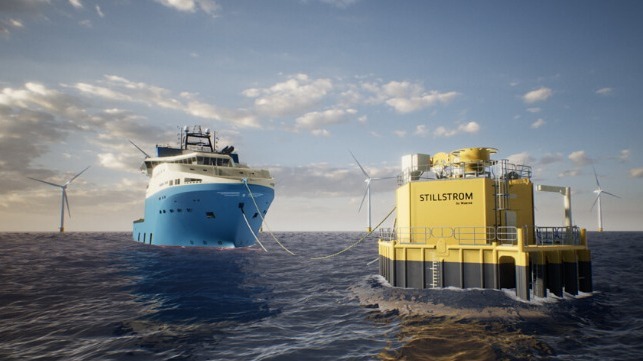Feasibility Study for Offshore Charging Buoy with Maersk and Aberdeen

A new round of testing is beginning for an offshore renewable charging hub developed by Maersk Supply Services that permits vessels to use the same concept as shore power while they are idle at sea. Stillstrom, a company launched by Maersk Supply Service to commercialize the technology, and the Port of Aberdeen located on the east coast of Scotland will conduct a joint feasibility study for the offshore charging hub.
Maersk announced the concept two years ago for the platform that provides a platform for vessels to utilize electricity from either offshore wind or grid energy, thereby eliminating the need for vessels to consume fossil fuels while idling. The product also allows for the charging of battery packs on vessels. Much the same way that vessels connect to shore power, they would connect to the buoy strategically placed offshore.
The prototype buoy was developed by Maersk Supply Service in partnership with Ørsted. The Danish Maritime Fund provided initial co-financing to conceptualize the project. The companies planned to test the charging buoy in 2021 by supplying overnight power to one of Ørsted’s offshore service vessels.
“The feasibility study we will undergo with Port of Aberdeen is a cornerstone in our go-to-market strategy for our ‘Ports & Hub’ segment,” said Kristian Jorgensen, CEO of Stillstrom. “Together with Port of Aberdeen as a close partner, we will be able to map and show the true value of utilizing electricity for idling vessels – which we expect will not only support the journey towards a net-zero ocean economy and a better near coastal environment, but also an economically attractive solution for vessels owners to utilize.”
The study, which will run until the end of the year, will develop a roadmap for the potential introduction of offshore charging infrastructure at the Port of Aberdeen. Stillstrom and the Port will analyze the benefits, use cases, fundamental requirements, economics, and stakeholder involvement as part of the study.
With more than 6,000 vessels visiting and anchoring outside the Port of Aberdeen each year, it is one of the UK’s busiest ports. The port, which sees calls from vessels for the offshore energy sector, as well as decommissioning, general cargo, cruise and ferry services, and is near the developing offshore wind farms is considered a strong candidate for the technology. “We look forward to working with Stillstrom to develop a low carbon power supply and reduce emissions from vessels on standby outside our port,” said Bob Sanguinetti, Chief Executive of the Port of Aberdeen.
Several similar projects are also being explored as a means of reducing emissions from near-shore shipping. Oasis Marine Power based in the U.K. completed sea trials for the first stage of testing of its offshore charging station held in the Port of Cromarty Firth, Scotland in January this year. Tests were also scheduled for this summer of a similar application with an electric charging station affixed to the base of a wind turbine at the UK's Lynn and Inner Dowsing offshore wind farms. The project supported by the Scottish Government is testing using electric power from the wind farm for the electric crew transfer vessels when they are tied up at the wind farm.
